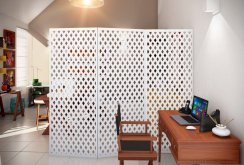Bathroom faucets: types and characteristics
A faucet is a necessary and extremely important attribute of a bathroom. In fact, without a faucet, a bathroom is not a bath at all, but a room of unknown purpose. This is the first. Now the second: the bathroom is a complex room. There is always a high level of humidity and temperature differences. That is, the bathroom has its own special microclimate, which affects every item in it. It is very important to choose and install here such equipment that could last for many years, and, in addition, be also aesthetic.Bathroom faucet: general description
One such item is a bathroom faucet. First you need to figure out what is the difference between the mixer and the tap. Water flows from the tap - cold or hot: it depends on which pipe (hot or cold) the tap is attached. The mixer in comparison with the crane - the device is more complex. The mixer (as its name implies) mixes cold and hot water. By adjusting the external devices of the mixer, the user achieves the water temperature that he needs. Therefore, the device of the mixer is more complicated than the device of the crane.Types of Mixers
Modern industry produces several types of bath faucets. To find out how one type differs from another, you need to make a brief overview of them:- Two-valve mixer. In essence, this is a classic version of the mixer. Such a mixer is equipped with two taps-boxes. Cold water flows through one tap, hot water through the other. The desired water temperature is achieved by turning the valves of the tap. The advantage of such a mixer is that by turning the valves, in the end, you can achieve the temperature of the water that is necessary for those who turn the valves. The disadvantage is that often the valves have to be turned for a long time, and this is tiring and annoying.
- Single-valve (aka single lever or flag) mixer.As the name implies, such a mixer is equipped with a single handle (it is a lever, it is a flag). Here you can set the desired water temperature by turning the handle left or right. There are also such types of single lever valves in which the lever does not turn left and right, but up and down. Such mixers are called joystick mixers.
- Contactless faucets. This is a new word in plumbing. Such mixers appeared relatively recently. Special sensors are mounted in their case. Such sensors are tuned to any movement. If some moving object (person) has appeared nearby, the sensors are triggered, and water starts to flow from the mixer. If the object is removed, the water stops flowing. You can change the temperature of the water by touching the mixer. Some versions of contactless faucets are equipped with a digital or color display, with which you can monitor the temperature of the water. These are very convenient devices, but their cost is quite high.
- Thermostatic mixers. The main feature of such mixers is that they can maintain the desired water temperature, regardless of what temperature the water enters. In addition, such mixers support the set pressure of water. Mixer adjustment is simple - with two knobs located at the edges. The right handle controls the temperature, the left - the pressure of the water. These are very comfortable devices, and therefore their price is high.
Materials of which mixers are made
Modern bath faucets are made from several materials:- From stainless steel. Such faucets are practical, reliable, durable, inexpensive, fit perfectly into the interior of the bathroom, and therefore - the most popular.
- From brass or bronze. Such faucets have a stylish appearance, they last a long time, but their price is relatively high.
- From ceramics. Ceramic faucets are diverse in terms of design, they have interesting and diverse forms. Their main disadvantages are fragility and high price.
- From silumin. Such mixers are the cheapest, but also the most unreliable in terms of service life. Silumin mixers serve a maximum of 2 years.
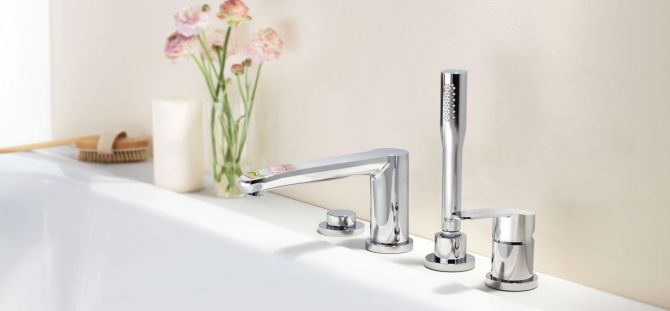
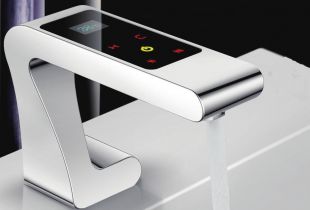 Thermostatic mixer: principle of operation and features (20 photos)
Thermostatic mixer: principle of operation and features (20 photos)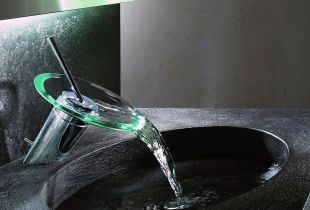 Cascading bath faucet: the elegance of waterfalls (26 photos)
Cascading bath faucet: the elegance of waterfalls (26 photos)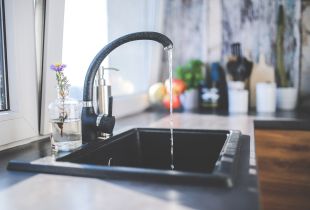 Stone faucet: unusual solutions in the interior (23 photos)
Stone faucet: unusual solutions in the interior (23 photos)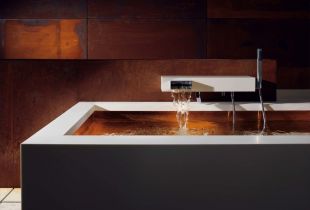 Shower set in the bathroom interior: modern designs (28 photos)
Shower set in the bathroom interior: modern designs (28 photos)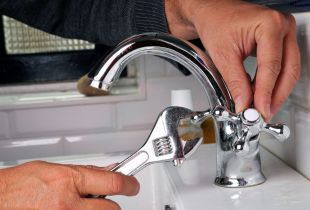 How to install the mixer: professional advice
How to install the mixer: professional advice




